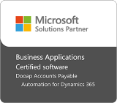Accounts Payable automation is a business imperative in today’s environment to enable critical finance operations to run smoothly, even under remote work requirements during a quarantine. By automating AP, organizations can efficiently and effectively process invoices, enabling suppliers to be paid on time, and money, goods and services to continue flowing between organizations.
So, once you realize that it’s time to automate AP, or achieve a higher level of automation, how do you get management buy-in?
The Time and Cost of Manual Processing Add Up Quickly
Often when preparing the business case for automation, companies start with the benefits it delivers to the AP organization, focusing on time and cost savings. For example, the effort it takes for a company to process tens or hundreds of thousands of invoices annually is substantial -- and costly. While the cost to process an invoice manually can vary according to the source measuring it – usually between $2-$30 – according to Ardent Partners and others, a reasonable average is about $10, which includes labor (in AP and other departments) and the cost of an ERP system where the invoices are sent for payment.
For example, using both the low and high figures, if you have 50,000 invoices annually, you would be paying either $100,000 at a cost of $2 per invoice or $1.5 million if you process them at $30 each. And, at the average cost of $10 per invoice, you’re looking at half a million dollars. Any way you look at it, it’s an expensive proposition. When you consider that an automation system might cost $50,000 to $100,000 and reduce your processing costs by up to 90%, the system could pay for itself very quickly.
Determining Your Manual Processing Costs
Instead of using averages, you could make a business case for AP automation by determining the cost of manually handling invoices at your company. Here are several key metrics to consider:
- AP and Finance staff costs
- How many people are processing invoices in AP?
- How much money would you save by saving even half of their time -- although automation would provide greater time savings than that?
- To get more specific, how much time are they spending on processing invoices?
- How much time are they spending managing the process – following up with reviewers or and dealing with suppliers who are checking the status of payments?
- How much time goes into managing exceptions? According to Ardent Partners, 25% of invoices are exceptions. What is the cost for that time?
- What are your logistical costs – the costs for managing the paper and the storage of paper invoices?
- How much time is it taking your organization to process an invoice from start to finish? One day, 15 or 30 days? Consider the wasted upside on the cash. If an invoice is sitting in your organization for 30 days, you're wasting cash that could be used in other ways, like getting dynamic discounts.
- How much are late payments costing you?
The Hidden Cost Savings
We’ve just been looking at savings within the AP and finance departments, but that’s just part of the picture. There are reviewers throughout your organization that spend time on invoices as well. Consider the time and costs that they are incurring:
- How much time are reviewers spending on approvals or managing the exceptions that come their way? It typically takes 1-3 minutes for a reviewer to approve an invoice. At 1 minute per invoice, it would take 50,000 minutes to process 50,000 invoices, and cost about $35,000 — (based on an annual salary of $84,000 or $ 0.7 per minute). If it takes 3 minutes to process invoices, it would cost $105,000.
- Exceptions add even more time. It’s not unrealistic for a reviewer to take 10 minutes or longer to research and review an exception, making the cost to approve an invoice much greater. Since about 25% of invoices are exceptions, you are wasting a lot of time throughout the organization to approve invoices manually – and costing the business a lot of money.
- Now consider how much faster it would be with automation, when approvals can be handled in seconds, rather than minutes. And, even more time can be shaved off if approvers are using a simple mobile app to do the work.
And, that’s not considering the lost opportunity cost of what AP professionals and others throughout the organization could be doing with their extra time.
The Priceless, Strategic Value of Real-time Data
Next, consider the strategic value of the real-time invoice data that automation delivers. Treasury could have real-time visibility into unrecorded liabilities and cash flow for better cash management. Accounting could be able to do month-end closes faster and more accurately. Business decisions could be made based on real-time, accurate information. While this is difficult to measure, the value is huge.
When you consider the unprecedented needs for streamlined, fast and mobile processing, there’s no doubt that AP automation is the smartest move. And when you add in all the cost, time and opportunity savings – not to mention the business benefit – it’s really a no-brainer. With all this ammunition, it should be easy to make a clear and compelling business case for AP automation to management.
Ready to automate your AP? Learn more about how to get started in the accounts payable automation process.








